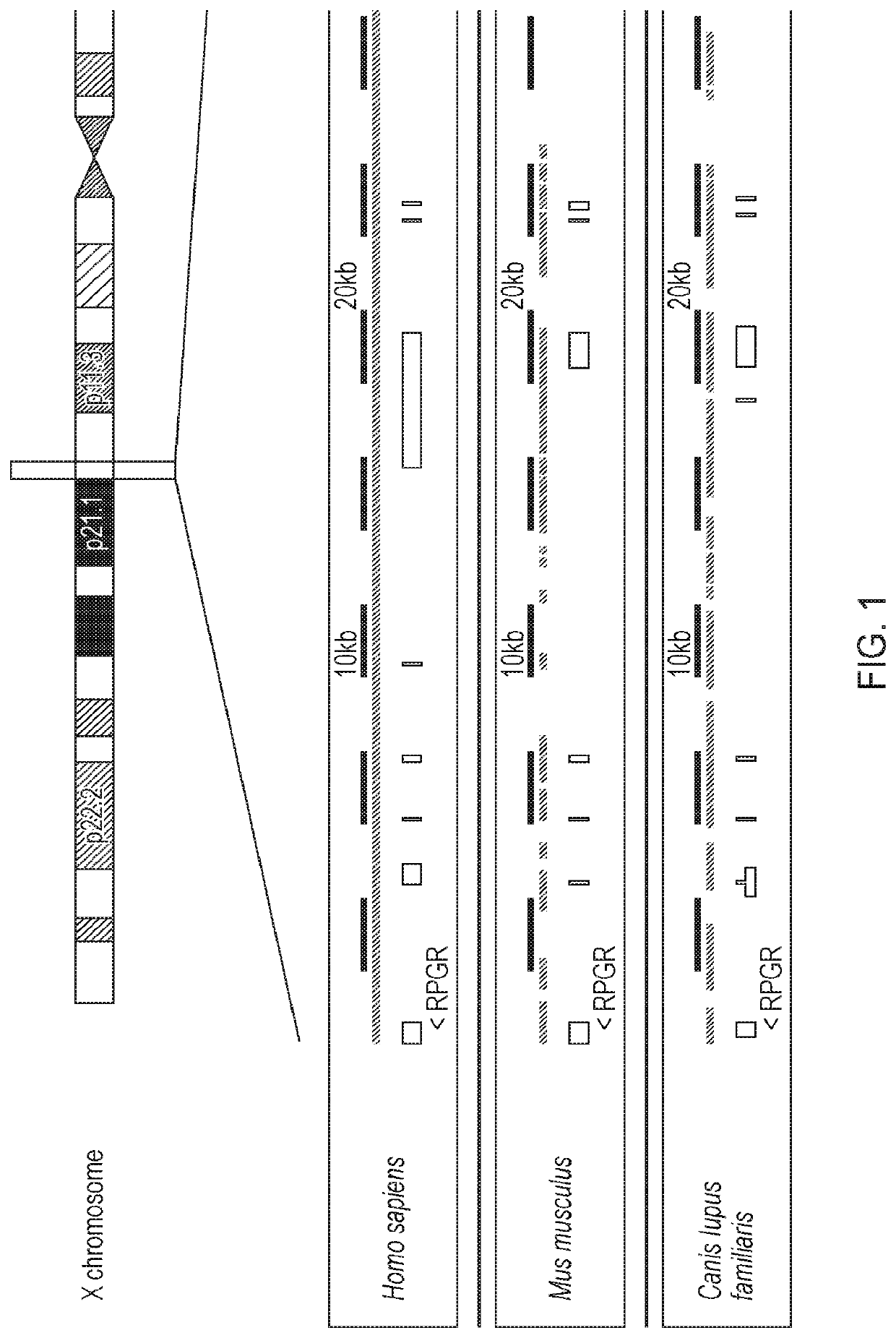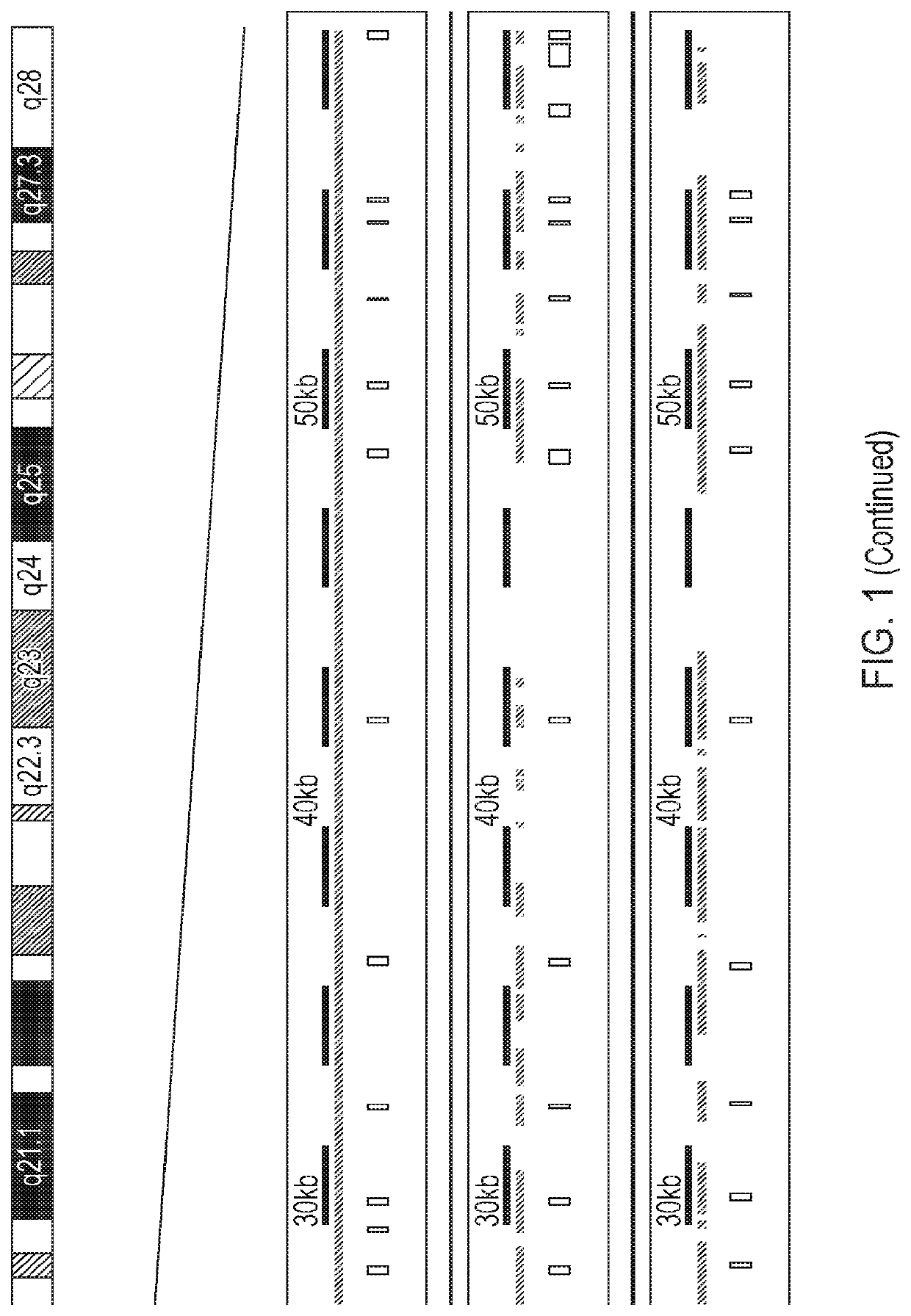Treatment of retinitis pigmentosa
a technology of retinitis pigmentosa and compound, which is applied in the field of compound for use in the gene therapy of eye diseases, can solve the problems of reducing central visual acuity, reducing the sensitivity of patients, so as to reduce the occurrence of mutations during replication, increase the fidelity of replication, and increase sequence stability
- Summary
- Abstract
- Description
- Claims
- Application Information
AI Technical Summary
Benefits of technology
Problems solved by technology
Method used
Image
Examples
example 1
Example 1A
Mouse Model Systems for X-linked Retinitis Pigmentosa
[0331]Certain species, for example mice and dogs, have genes that are homologous to human RPGR (compare the yellow exonic sequences shown in FIG. 1). Such species may therefore serve as potential models for X-linked retinitis pigmentosa caused by mutations in human RPGR.
[0332]Two mouse models were obtained to test the safety and efficacy of the therapeutic vector in this study. Both have alterations in the homologous gene Rpgr.[0333]1. The Rpgr ‘1’ strain: this strain was engineered by targeted disruption of parts of exon 4 though part of exon 6 by a sequence containing genes encoding β-galactosidase and a neomycin resistance marker (Hong D. H. et al. (2000) Proc. Natl. Acad. Sci. USA 97: 3649-3654).[0334]2. The Rd9 strain: this strain features a naturally occurring insertional mutation of 32 bp which leads to a frameshift (Thompson D. A. et al. (2012) PLoS One 7: e35865).
[0335]Both Rpgr− / − and Rd9 mouse models lack Rpgr...
example 1b
Codon Optimisation of RPGR
RPGR Codon Optimisation
[0336]A synthetic RPGRORF15 sequence was prepared using codon optimisation (coRPGR, “Optimized”; SEQ ID NO: 3) to stabilise the highly mutagenic purine-rich region (FIG. 2).
Characterisation of the Codon Optimised RPGR Gene
[0337]Cloning efficiency and sequence fidelity were compared between the wild type and codon optimised sequences in a standard cloning vector (FIG. 3A-D).
[0338]Using a restriction digest analysis, only 3 out of 24 clones were found to successfully feature the wild type sequence (wtRPGR; FIG. 3B, successful clones highlighted with asterisks). In contrast, 18 out of 24 clones successfully featured the correct codon optimised sequence (coRPGR; FIG. 3D).
[0339]Plasmid yields from minipreparations were found to be higher using the coRPGR sequence than the wtRPGR (FIG. 3E), even though a similar level of sample purity was maintained (FIG. 3F). In support of this finding, total plasmid yield from megapreparations (FIG. 3G) w...
example 1c
AA V-Mediated In Vivo Delivery of Codon Optimised RPGR
[0352]The coRPGR sequence was packaged into an AAV2 / 8 vector, which was used to introduce RPGR into the photoreceptor cells of mice lacking RPGR expression (the Rd9 and Rpgr_ / ˜mouse strains). In more detail, the transgene cassette featured a rhodopsin kinase promoter and Kozak consensus sequence upstream of the coRPGR polynucleotide sequence, and a polyA sequence from the bovine growth hormone downstream of the coding sequence.
coRPGR Leads to RPGR Protein Expression in Rd9 and Rpgr− / − Mice
[0353]Western blot analyses showed that treatment of Rd9 and Rpgr− / − mice with an AAV. coRPGR vector leads to RPGR protein expression (FIG. 7A). Furthermore, immunohistochemical staining for RPGR was performed on treated and untreated eyes from Rd9 and Rpgr− / − mice and demonstrated correct localisation of the protein product (FIG. 7B).
Gene Augmentation with coRPGR Leads to a Therapeutic Effect in Rd9 and Rpgr− / − Mice
[0354]Both Rd9 and Rpgr− / − mo...
PUM
 Login to View More
Login to View More Abstract
Description
Claims
Application Information
 Login to View More
Login to View More - R&D
- Intellectual Property
- Life Sciences
- Materials
- Tech Scout
- Unparalleled Data Quality
- Higher Quality Content
- 60% Fewer Hallucinations
Browse by: Latest US Patents, China's latest patents, Technical Efficacy Thesaurus, Application Domain, Technology Topic, Popular Technical Reports.
© 2025 PatSnap. All rights reserved.Legal|Privacy policy|Modern Slavery Act Transparency Statement|Sitemap|About US| Contact US: help@patsnap.com



